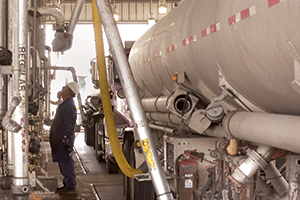Senior Reporter
Diesel Price Drops 2.4¢ to $2.421; Gasoline Declines 3.5¢ to $2.059

The U.S. average retail price of diesel continued its descent for a third straight week, falling 2.4 cents a gallon to $2.421, the Department of Energy reported.
Trucking’s main fuel is now $1.184 a gallon cheaper than a year ago, when the price was $3.605, the agency reported Nov. 30.
Diesel prices fell in all regions except New England — where it rose three-tenths of a cent to $2.527.
DOE’s Energy Information Administration also said the national average price of gasoline fell 3.5 cents to $2.059 a gallon, as prices dropped in all regions except, again, New England, where it rose two-tenths of a cent to $2.15.
Meanwhile, crude oil futures remained below $45 a barrel, closing at $41.71 on Nov. 30, or $29.14 less than Nov. 28 a year earlier.
“Look at the difference in the price [of diesel fuel] from a year ago. I think a lot of it has to do with crude oil prices in the low $40s,” Denton Cinquegrana, the chief oil analyst at the Oil Price Information Service in Gaithersburg, Maryland, told Transport Topics. “We didn’t have that at this time last year.”
He said he saw an “outside shot” of oil falling below $40 a barrel, as happened in late August, if supplies remain high, which could drive diesel prices down, too.
The price for a barrel of West Texas Intermediate crude last fell below $40 on Aug. 24, when it was $38.24, the lowest price since February 2009. West Texas crude is used as a benchmark in oil pricing.
The price of diesel on Aug. 24 was $2.561, EIA said.
Meanwhile, OPEC was scheduled to meet in Vienna on Dec. 4, after Transport Topics went to press, to discuss production quotas among other issues.
Bloomberg News said oil is set to average less than $50 for a fourth month, the longest stretch since the global financial crisis, as a record supply glut showed no signs of ending as producers fight for market share. Iran has said it will announce plans during the Vienna meeting to expand output, a year after Saudi Arabia led an OPEC decision to keep pumping and drive out higher-cost shale rivals.
“As the ministers arrive in Vienna, the rhetoric will start to fly,” John Kilduff, a partner at Again Capital, a New York-based hedge fund, told Bloomberg earlier in the week. “The market is going to be headline-driven and very volatile this week. The bulls are especially desperate and will try to bid up the market on any sign of a cutback.”
A lot of new refining capacity is coming online in Asia and the Middle East, Cinquegrana said, and is geared to making and exporting diesel fuel to South and Central America, which are export markets for U.S.-made diesel, too.
“If [buyers in those regions] can get it from them at cheaper prices, obviously it is going to back up some of the potential export lanes, and U.S. supply will continue to build and prices should stay down.”
However, he said, one domestic factor that could push fuel prices somewhat higher is the Environmental Protection Agency’s new renewable fuel standard, issued Dec. 1, that boosts production of those fuels, including biodiesel, which is used by fleets.
The EPA said in statement that with the final standard, “biofuel producers and blenders are in a better position to plan and invest — putting the market on stable ground and supporting further growth and innovation in the renewable fuels industry.”
Under the standard, the amount of advanced biodiesel produced would climb 25% in 2016 to 3.61 billion gallons compared with 2.88 billion in 2015.
Biodiesel is a more expensive component to add to diesel stock. It also requires a unique identifier called a renewable identification number, or RIN, which can prove a refinery has blended the required amount into the diesel, Cinquegrana said.
RINs are sold by those refineries that have exceeded the requirements to those that have not, he said.
“I get the sense that there may be higher RIN prices for biodiesel, which eventually get passed down. Biofuel is not cheap,” Cinquegrana said. “I just don’t know how long [any added cost] will take to find its way in, but I don’t think it is going to be dimes and quarters. I think it’s more like pennies.”




